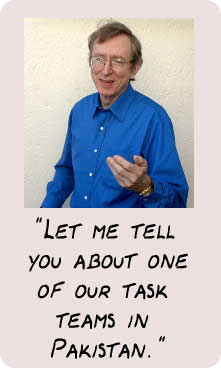|
|
Katalina Groh, Larry Prusak: Some of the world's leading thinkers |
| Storytelling to ignite change: Steve Denning |
 |
The
Pakistan story
One of those occasions
was the Fall of 1998. You may recall that this was a time when the entire
financial world seemed to be coming apart at the seams.
|
| They were beginning to think: “In
the midst of a financial crisis, it’s obvious that the world needs a lending
organization, like the World Bank. That’s what we know how to do. So why
were we wasting our time on knowledge? Why don’t we get back to focusing,
as we have always done, on being a bank and help solve the financial crisis?”
And so they called a big meeting in September 1998, and I was asked to make a presentation to the president and the senior management of the World Bank on “the status of the knowledge management program.” In a sense, what they were asking me to do was: “Define knowledge management or die!” And I knew that if I did define it, I would die. So I didn’t define it. I did something else instead. Pakistan Highways
“Just a few weeks ago, on August 20, the government of Pakistan asked our field office in Pakistan for help in the highway sector. They were experiencing widespread pavement failure. The highways were falling apart. They felt they could not afford to maintain them. They wanted to try a different technology, a technology that our organization has not supported or recommended in the past. And they wanted our advice within a few days. “And what’s enabling this to happen is not just the technology that’s weaving these three hundred people together in a seamless electronic web, but the fact that these people form a community. The fact that they know each other. Because when the task team leader in Pakistan asks for advice, essentially he’s saying, ‘I don’t know. I don’t know the answer to what might be a central question in my sector, and I am paid to know the answers to central questions in my sector. And I work in an organization that is downsizing and looking around for employees who don’t know the answers to central questions in their sector.’ And so he doesn’t ask the question, unless he knows it’s safe. And the only reason he knows it is safe is that the knows the recipients of the email because they form a kind of highways community, and in this community, he knows that it is o.k. to ask questions and admit that you don’t know, and people don’t find fault with that. They don’t say, ‘You ask questions, so you’re a problem: we want you out of the organization.’ Instead, they try to help you find the answer.”The impact of the story So that story enabled me to
connect with the World Bank senior management and communicate the idea
of knowledge management to the World Bank. And they started to think: “Well,
that’s remarkable how quickly we could respond to that kind of situation
in that out-of-the-way part of the world. Imagine if we had that kind of
capability, not just in the highways community, but all across the organization.
Imagine if the whole World Bank functioned like this.” And in effect, they
said, “Let’s do it! Let’s become an agile knowledge sharing organization.”
And so the outcome of the meeting was not, as some had expected, a court
martial looking into why there were so many flaws and blemishes in the
implementation of this massive effort at transformation. Instead, the meeting
led to a whole new surge of momentum behind knowledge sharing to make that
something that was uniform across the whole organization. And so I found
that storytelling was not ephemeral and nebulous and worthless. Instead
I found that it was an extremely powerful tool to get major change in this
large change-resistant organization.
|
| Books and videos on storytelling *** In Good Company : How Social Capital Makes Organizations Work by Don Cohen, Laurence Prusak (February 2001) Harvard Business School Press *** The Social Life of Information, by John Seely Brown, Paul Duguid (February 2000) Harvard Business School Press *** The Springboard : How Storytelling Ignites Action in Knowledge-Era Organizations by Stephen Denning (October 2000) Butterworth-Heinemann *** The Art of Possibility, a video with Ben and Ros Zander : Groh Publications (February 2001) |
| The views expressed on this website are those of the authors, and not necessarily those of any person or organization |
| Site optimized in 800x600: webmaster CR WEB CONSULTING |
|
|
|
|